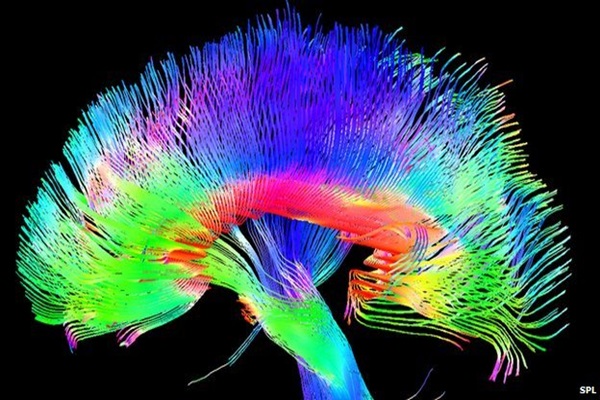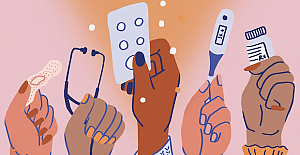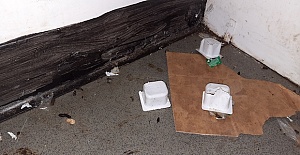Participants' brain scans revealed that artists had increased neural matter in areas relating to fine motor movements and visual imagery. The research, published in NeuroImage, suggests that an artist's talent could be innate. But training and environmental upbringing also play crucial roles in their ability, the authors report. As in many areas of science, the exact interplay of nature and nurture remains unclear. Lead author Rebecca Chamberlain from KU Leuven University, Belgium, said she was interested in finding out how artists saw the world differently. "The people who are better at drawing really seem to have more developed structures in regions of the brain that control for fine motor performance and what we call procedural memory," she explained. In their small study, researchers peered into the brains of 21 art students and compared them to 23 non-artists using a scanning method called voxel-based morphometry.
Detail of 'Giant Lobster' from NHM specimen collection One artist who has practised for many years is Alice Shirley - here is a detail of her Giant Lobster
These detailed scans revealed that the artist group had significantly more grey matter in an area of the brain called the precuneus in the parietal lobe. "This region is involved in a range of functions but potentially in things that could be linked to creativity, like visual imagery - being able to manipulate visual images in your brain, combine them and deconstruct them," Dr Chamberlain told the BBC's Inside Science programme. "I had a very arty family. My mother was an art historian and my dad a photographer.Participants also completed drawing tasks and the team looked at the relationship between their performance in this task and their grey and white matter.
A changing brain
Those better at drawing had increased grey and white matter in the cerebellum and also in the supplementary motor area - both areas that are involved with fine motor control and performance of routine actions. Grey matter is largely composed of nerve cells, while white matter is responsible for communication between the grey matter regions. But it is still not clear what this increase of neural matter might mean. From looking at related studies of other creative people, such as musicians, it suggests that these individuals have enhanced processing in these areas, Dr Chamberlain added. "It falls into line with evidence that focus of expertise really does change the brain. The brain is incredibly flexible in response to training and there are huge individual differences that we are only beginning to tap into."
A life-size drawing of the giant squid specimen in the NHM collection, painted in fresh squid ink Another author of the paper, Chris McManus from University College London, said it was difficult to distinguish what aspect of artistic talent was innate or learnt. "We would need to do further studies where we look at teenagers and see how they develop in their drawing as they grow older - but I think [this study] has given us a handle on how we could begin to look at this."
No 'right' side
Ellen Winner of Boston College, US, who was not involved with the study, commented that it was very interesting research. She said it should help "put to rest the facile claims that artists use 'the right side of their brain' given that increased grey and white matter were found in the art group in both left and right structures of the brain". "Only a prospective study could get at the question of innate structural brain differences that predispose people to become visual artists, and this kind of study has not been done as it would be very difficult and very expensive to carry out."


 Prime Minister Keir Starmer's 2025 Easter message
Prime Minister Keir Starmer's 2025 Easter message After Nesil Caliskan a by-election will be held in Jubilee ward in Enfield
After Nesil Caliskan a by-election will be held in Jubilee ward in Enfield Publishing the analysis, Labour’s Cllr Ergin Erbil said Everybody in Enfield deserves basic rights
Publishing the analysis, Labour’s Cllr Ergin Erbil said Everybody in Enfield deserves basic rights Gaza-Israel conflict Statement from Cllr Ergin Erbil, Leader of Enfield Council
Gaza-Israel conflict Statement from Cllr Ergin Erbil, Leader of Enfield Council UK AMBASSADOR TO TURKEY VISITS FETHIYE
UK AMBASSADOR TO TURKEY VISITS FETHIYE Journalists from Europe held the Turkish Media Workshop in Skopje
Journalists from Europe held the Turkish Media Workshop in Skopje The European Union called on Turkey to uphold democratic values
The European Union called on Turkey to uphold democratic values Turkish citizens in London said Rights, Law, Justice
Turkish citizens in London said Rights, Law, Justice The 'Prince of Paris' has impressed in his first EuroLeague season
The 'Prince of Paris' has impressed in his first EuroLeague season Saran Media And Euroleague Basketball Extend Media Rights Partnership for Four More Years
Saran Media And Euroleague Basketball Extend Media Rights Partnership for Four More Years Will Rangers be Jose Mourinho’s next victim?
Will Rangers be Jose Mourinho’s next victim? Jose Mourinho's Fenerbahce face Rangers on Thursday
Jose Mourinho's Fenerbahce face Rangers on Thursday Residents welcomed back to Edmonton Leisure Centre
Residents welcomed back to Edmonton Leisure Centre Barclays has become the biggest UK lender so far to cut mortgage rates
Barclays has become the biggest UK lender so far to cut mortgage rates THE SPRING STATEMENT EXPLAINED, UK ECONOMIC OUTLOOK AND GROWTH FORECASTS
THE SPRING STATEMENT EXPLAINED, UK ECONOMIC OUTLOOK AND GROWTH FORECASTS Launch of Made in Enfield gift shop to celebrate local artists and designers
Launch of Made in Enfield gift shop to celebrate local artists and designers




















